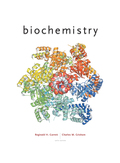
Concept explainers
Answers to all problems are at the end of this book. Detailed solutions are available in the Student Solutions Manual, Study Guide, and Problems Book.
Determining the Branch Points and Reducing Ends of Amylopectin A 0.2-g sample of amylopectin was analyzed to determine the fraction of the total glucose residues, that are branch points in the structure. The sample was exhaustively methylated and then digested, yielding 50-μmol of 2,3-dimethylgluetose and 0.4 μmol of 1,2,3,6- letramethylglucose.
- What fraction of the total residues are branch points?
- I low many reducing ends does this sample of amylopectin have?
(a)
Interpretation:
The fraction of the total residues that are branch points in the structure of amylopectin is to be calculated.
Concept Introduction:
The simplest hydrolyzed form that is obtained from the carbohydrates is known as monosaccharide. Polysaccharides are those types of sugars which contain more than ten units of monosaccharides.
Amylopectin is a polysaccharide and is one of the two forms of starch. It is composed of long chain of glucose attached by the
Answer to Problem 8P
The fraction of the total residues that are branch points in the structure of amylopectin is
Explanation of Solution
The given mass of amylopectin sample is
The given amount of
The conversion of
Thus, the moles of
The given amount of
The molecular weight of glucose is
The molecular weight of water is
If glucose unit losses a water molecule while forming a glycosidic linkage in amylopectin, then, the molecular weight of glucose in amylopectin is
The moles of a substance is calculated by the equation as,
Substitute the value of mass and molar mass of the sample in the above equation.
The moles of
Substitute the values of moles of
Thus, the fraction of the total residues that are branch points in the structure of amylopectin is
(b)
Interpretation:
The total number of reducing ends possessed by the sample of amylopectin is to be calculated.
Concept Introduction:
The simplest hydrolyzed form that is obtained from the carbohydrates is known as monosaccharide. Polysaccharides are those types of sugars which contain more than ten units of monosaccharides.
Amylopectin is a polysaccharide and is one of the two forms of starch. It is composed of long chain of glucose attached by the
Answer to Problem 8P
The total number of reducing ends possessed by the sample of amylopectin is
Explanation of Solution
The given amount of
The moles of the reducing ends is calculated by the moles of
If one mole of compounds possesses
Thus, the total number of reducing ends possessed by the sample of amylopectin is
Want to see more full solutions like this?
Chapter 7 Solutions
EBK BIOCHEMISTRY
- The following data were recorded for the enzyme catalyzed conversion of S -> P. Question: Estimate the Vmax and Km. What would be the rate at 2.5 and 5.0 x 10-5 M [S] ?arrow_forwardPlease helparrow_forwardThe following data were recorded for the enzyme catalyzed conversion of S -> P Question: what would the rate be at 5.0 x 10-5 M [S] and the enzyme concentration was doubled? Also, the rate given in the table is from product accumulation after 10 minuets of reaction time. Verify these rates represent a true initial rate (less than 5% turnover). Please helparrow_forward
- The following data was obtained on isocitrate lyase from an algal species. Identify the reaction catalyzed by this enzyme, deduce the KM and Vmax , and determine the nature of the inhibition by oxaloacetate. Please helparrow_forwardIn the table below, there are sketches of four crystals made of positively-charged cations and negatively-charged anions. Rank these crystals in decreasing order of stability (or equivalently increasing order of energy). That is, select "1" below the most stable (lowest energy) crystal. Select "2" below the next most stable (next lowest energy) crystal, and so forth. A B 鹽 (Choose one) +2 C +2 +2 (Choose one) D 鹽雞 (Choose one) (Choose one)arrow_forward1. Draw the structures for the fats A. 16:2: w-3 and B. 18:3:49,12,15 2. Name each of the molecules below (image attached)arrow_forward
- draw the structures for the fats A. 16:2:w-3 B 18:3:9,12,15arrow_forward1. Below is a template strand of DNA. Show the mRNA and protein that would result. label the ends of the molecules ( refer to attached image)arrow_forwardAttach the followina labels to the diagram below: helicase, single stranded binding proteins, lagging strand, leading strand, DNA polymerase, primase, 5' ends (3), 3' ends (3) (image attached)arrow_forward
- 1. How much energy in terms of ATP can be obtained from tristearin (stearate is 18:0) Show steps pleasearrow_forwardMultiple choice urgent!!arrow_forward1. Write the transamination reaction for alanine. Indicate what happens next to each of the molecules in the reaction, and under what conditions it happens. 2.arrow_forward
 BiochemistryBiochemistryISBN:9781305577206Author:Reginald H. Garrett, Charles M. GrishamPublisher:Cengage Learning
BiochemistryBiochemistryISBN:9781305577206Author:Reginald H. Garrett, Charles M. GrishamPublisher:Cengage Learning
